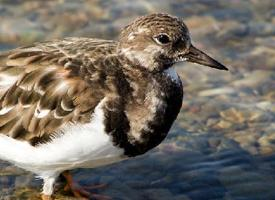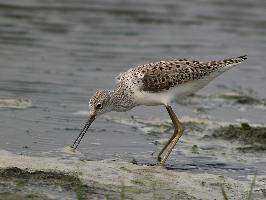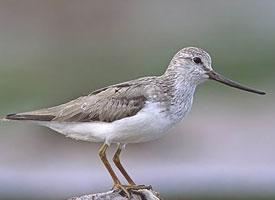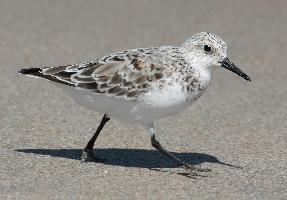
Popis zvířete
The Ruddy Turnstone (Arenaria interpres) is a small, highly migratory bird that belongs to the sandpiper family Scolopacidae. This species exhibits a striking appearance and fascinating behaviors, making it a subject of interest for birdwatchers and ornithologists alike.Physical Description:
Adult Ruddy Turnstones have a distinctive appearance, especially during the breeding season. They sport a unique pattern of black and white on their face and breast, with a bright rufous or chestnut back, which gives them their common name. Their underparts are white, and they have a short, stout, dark bill that is slightly upturned at the tip, which they use adeptly to flip over stones and debris in search of food. Their legs are bright orange, adding to their colorful appearance. In winter, their plumage becomes more subdued, with gray-brown tones dominating, though they maintain the patterned face that aids in identification year-round.
Size and Shape:
Ruddy Turnstones are relatively small birds, with a body length typically ranging from 21 to 26 cm (8.3 to 10.2 inches) and a wingspan of 50 to 57 cm (19.7 to 22.4 inches). They have a stocky build, with a short neck and a robust body, giving them a somewhat plump appearance. Their wings are pointed, aiding in their long migratory flights.
Behavior:
Ruddy Turnstones are known for their energetic foraging behavior. They are often seen darting along shorelines, flipping over stones, seaweed, and other debris with their bills to uncover hidden prey such as insects, crustaceans, and mollusks. This behavior is not only fascinating to observe but also indicative of the bird's name. They are also known to feed on carrion and human refuse, showcasing their adaptability.
Habitat and Distribution:
The Ruddy Turnstone has a circumpolar distribution, breeding in arctic and subarctic regions of North America, Europe, and Asia. Their breeding habitats are typically rocky and pebble-strewn tundra near coasts. After the breeding season, they migrate long distances to wintering grounds, which can be as far south as South America, southern Africa, and Australasia. During migration and in their wintering habitats, they are commonly found along coastlines, including rocky shores, sandy beaches, mudflats, and estuaries, as well as inland on occasion.
Migration:
Ruddy Turnstones are remarkable migrants, undertaking long journeys between their breeding and wintering grounds. These migrations are undertaken in stages, with birds stopping at key sites to refuel. Their flights are strong and direct, and they are capable of flying across large expanses of open water.
Reproduction:
During the breeding season, Ruddy Turnstones return to the arctic tundra, where they perform elaborate courtship displays, including aerial maneuvers and calls. They nest on the ground, with nests being simple scrapes lined with leaves and lichen. The female lays a clutch of 2-5 eggs, which are incubated by both parents. The chicks are precocial, able to leave the nest soon after hatching, but they are still tended and fed by both parents until they fledge.
Conservation Status:
The Ruddy Turnstone is currently listed as Least Concern by the IUCN, indicating that it is not currently at immediate risk of widespread decline. However, like many migratory shorebirds, it faces threats from habitat loss and degradation, especially in its wintering and stopover habitats. Conservation efforts focusing on the protection of critical habitats along its migratory routes are essential for ensuring the long-term survival of this species.
In summary, the Ruddy Turnstone is a vibrant and adaptable shorebird with a broad geographical range. Its colorful plumage, intriguing foraging behaviors, and impressive migratory feats make it a fascinating subject for study and observation.
Podobná zvířata
Nové fotografie zvířat
Top 10 zvířat
- Common cockchafer (Melolontha melolontha)
- Common house mosquito (Culex pipiens)
- Colossal squid (Mesonychoteuthis hamiltoni)
- Giant house spider (Eratigena atrica)
- Harpy eagle (Harpia harpyja)
- Fruit fly (Drosophila melanogaster)
- Common reed warbler (Acrocephalus scirpaceus)
- Australian box jelly (Chironex fleckeri)
- Proboscis monkey (Nasalis larvatus)
- Moustached guenon (Cercopithecus cephus)


